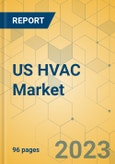Speak directly to the analyst to clarify any post sales queries you may have.
KEY HIGHLIGHTS:
- Rising demand for energy-efficient HVAC systems in the US is anticipated to surge the demand for services during the forecast period. This is since all new residential air-source heat pump systems and central air-conditioning sold in the region will be required to meet new energy efficiency standards.
- The US market is witnessing significant growth due to changing and diverse climatic conditions. In 2022, the US recorded around 122,638 heating and air conditioning contractors.
- In 2022, the Southern region held the largest market share in the US HVAC market. It has the highest number of households with rising annual household incomes. New construction in the South is anticipated to stimulate the adoption of HVAC systems.
- The US focuses on accelerating sustainability goals by rejoining the Paris Agreement and strengthening 2030 greenhouse gas emission objectives, decarbonization, electrification, and low-global warming potential (GWP) refrigerant evolutions.
- With the increase in awareness of global warming, harmful gas emission, and other factors, the US government offers several tax credits programs that reward consumers adopting products promoting high energy savings. For this purpose, the Energy Star Program came forth, and the ENERGY STAR is awarded to products for offices and homes that are highly energy efficient.
- Factors such as wellness, ventilation, indoor air quality, thermal health, and humidity are a few key pillars of healthy commercial buildings. The launch of the US Environmental Protection Agency’s (EPA) Clean Air in Buildings Challenge, along with the factors mentioned earlier, makes HVAC performance and a healthy indoor environment more significant than before.
- Advanced controls play an essential role in supporting HVAC system efficiency. Incorporating artificial intelligence (AI) with advanced commercial building management systems offers operators a complete set of apps to monitor and expand energy competence, asset performance, maintenance operations, and occupant satisfaction and well-being.
- Commercial building managers take advantage of electric-based heating, cooling systems, and advanced controls that improve performance and competence. According to Johnson Controls, one of the prominent vendors in the energy efficiency indicator survey 2022, 62% of commercial organizations is anticipated to rise investments in energy effectiveness, renewable energy, or smart building technology in 2023.
LIST OF VENDORS
Key Vendors
- Daikin
- Carrier
- Lennox International
- Ingersoll Rand
- Johnson Controls
- Rheem Manufacturing
Other Prominent Vendors
- Honeywell
- Danfoss
- Mitsubishi Electric
- Zehnder
- S&P
- Hitachi
- Alfa Laval
- Nortek
- TCL Electronics
- Camfil
- Dunham Bush
- Backer Springfield
- Fujitsu
- Onda
REPORT HIGHLIGHTS
SEGMENTATION & FORECAST
- Equipment (Revenue)
- Heating
- Heat Pumps
- Boiler Units
- Furnaces
- Others
- Air Conditioning
- RACs
- CACs
- Chillers
- Heat Exchangers
- Others
- Ventilation
- Air Handling Units
- Air Filters
- Humidifiers & Dehumidifiers
- Fan Coil Units
- Others
- End-User (Revenue)
- Residential
- Commercial
- Office Space
- Airport & Public Utilities
- Hospitality
- Hospitals
- Industrial & Others
MARKET STRUCTURE
- Market Dynamics
- Competitive Landscape of US HVAC
- Key Vendors
- Other Prominent Vendors
Table of Contents
Companies Mentioned
- Daikin
- Carrier
- Lennox International
- Ingersoll Rand
- Johnson Controls
- Rheem Manufacturing
- Honeywell
- Danfoss
- Mitsubishi Electric
- Zehnder
- S&P
- Hitachi
- Alfa Laval
- Nortek
- TCL Electronics
- Camfil
- Dunham Bush
- Backer Springfield
- Fujitsu
- Onda
Methodology
Our research comprises a mix of primary and secondary research. The secondary research sources that are typically referred to include, but are not limited to, company websites, annual reports, financial reports, company pipeline charts, broker reports, investor presentations and SEC filings, journals and conferences, internal proprietary databases, news articles, press releases, and webcasts specific to the companies operating in any given market.
Primary research involves email interactions with the industry participants across major geographies. The participants who typically take part in such a process include, but are not limited to, CEOs, VPs, business development managers, market intelligence managers, and national sales managers. We primarily rely on internal research work and internal databases that we have populated over the years. We cross-verify our secondary research findings with the primary respondents participating in the study.

LOADING...
Table Information
| Report Attribute | Details |
|---|---|
| No. of Pages | 96 |
| Published | June 2023 |
| Forecast Period | 2022 - 2028 |
| Estimated Market Value ( USD | $ 27.85 Billion |
| Forecasted Market Value ( USD | $ 33.81 Billion |
| Compound Annual Growth Rate | 3.2% |
| Regions Covered | United States |
| No. of Companies Mentioned | 20 |









